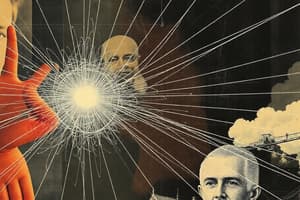Podcast
Questions and Answers
What indicates a stronger electric field in a given region?
What indicates a stronger electric field in a given region?
- Closer electric field lines (correct)
- Longer electric field lines
- Electric field lines starting on negative charges
- Electric field lines crossing each other
According to Coulomb's Law, what happens to the force between two charged objects if the distance between them is halved?
According to Coulomb's Law, what happens to the force between two charged objects if the distance between them is halved?
- The force remains the same
- The force doubles
- The force becomes zero
- The force quadruples (correct)
Which statement is true about electric field lines?
Which statement is true about electric field lines?
- They start on negative charges and end on positive charges
- They can cross each other to show varying strengths
- They are always parallel to the surface of conductors
- They point away from positive charges and toward negative charges (correct)
Coulomb's Law indicates that the force between two charges is attractive when:
Coulomb's Law indicates that the force between two charges is attractive when:
What is the primary purpose of electric field lines?
What is the primary purpose of electric field lines?
What does Coulomb's Law primarily describe?
What does Coulomb's Law primarily describe?
Coulomb's constant is approximately equal to which value?
Coulomb's constant is approximately equal to which value?
If two charges have the same sign, what type of force do they exert on each other?
If two charges have the same sign, what type of force do they exert on each other?
What do electric field lines indicate about the force experienced by a positive test charge?
What do electric field lines indicate about the force experienced by a positive test charge?
What happens to the electric field lines when charges are placed close together?
What happens to the electric field lines when charges are placed close together?
In the vector form of Coulomb's Law, what does the unit vector $, \hat{r}$ represent?
In the vector form of Coulomb's Law, what does the unit vector $, \hat{r}$ represent?
What is a characteristic of electric field lines in static electric fields?
What is a characteristic of electric field lines in static electric fields?
Which of the following describes the relationship between force, charge, and distance in Coulomb's Law?
Which of the following describes the relationship between force, charge, and distance in Coulomb's Law?
Why can't electric field lines form closed loops?
Why can't electric field lines form closed loops?
Which statement is true regarding the direction of electric field lines?
Which statement is true regarding the direction of electric field lines?
Flashcards are hidden until you start studying
Study Notes
Electric Field Lines
- Definition: Imaginary lines that represent the direction and strength of an electric field.
- Properties:
- Lines start on positive charges and end on negative charges.
- The density of lines indicates the strength of the electric field – closer lines mean a stronger field.
- Lines never cross each other.
- Electric field lines are perpendicular to surfaces of conductors in electrostatic equilibrium.
- Direction:
- Away from positive charges.
- Toward negative charges.
- Applications: Useful for visualizing electric fields created by point charges and distributions.
Coulomb's Law Derivation
-
Concept: Coulomb's Law describes the force between two charged objects.
-
Mathematical Formulation:
-
The force ( F ) between two point charges ( Q_1 ) and ( Q_2 ) separated by a distance ( r ) in a vacuum is given by:
[ F = k \frac{|Q_1 Q_2|}{r^2} ]
where ( k ) is Coulomb's constant (( k \approx 8.99 \times 10^9 , \text{N m}^2/\text{C}^2 )).
-
-
Derivation Steps:
- Experimental observations: The force is proportional to the product of the magnitudes of the charges and inversely proportional to the square of the distance between them.
- Vector Form:
- The force vector points along the line joining the charges.
- Attractive force for opposite charges and repulsive for like charges.
- Units: Charges in coulombs (C), force in newtons (N), and distance in meters (m).
-
Applications: Used to calculate forces in electrostatics, charge interactions, and electric field calculations.
Electric Field Lines
- Imaginary lines representing the direction and strength of an electric field
- Start on positive charges and end on negative charges
- Line density indicates field strength: closer lines mean a stronger field
- Lines never cross each other
- Perpendicular to surfaces of conductors in electrostatic equilibrium
- Direction: away from positive charges, towards negative charges
- Useful for visualizing electric fields created by point charges and distributions
Coulomb's Law
- Describes the force between two charged objects
- Force ( F ) between charges ( Q_1 ) and ( Q_2 ) separated by distance ( r ) is: ( F = k \frac{|Q_1 Q_2|}{r^2} ) where ( k \approx 8.99 \times 10^9 , \text{N m}^2/\text{C}^2 )
- Derived by observing that force is proportional to the product of charges and inversely proportional to the square of the distance
- Force vector points along the line joining the charges, attractive for opposite charges and repulsive for like charges
- Units: charges in coulombs (C), force in newtons (N), and distance in meters (m)
- Used to calculate forces in electrostatics, charge interactions, and electric field calculations
Coulomb's Law
- Describes the electrostatic force between two charged objects
- Force is directly proportional to the product of the charges and inversely proportional to the square of the distance separating them
- Formula: ( F = k \frac{|q_1 q_2|}{r^2} )
- ( F ) is the magnitude of the force
- ( k ) is Coulomb's constant (( 8.99 \times 10^9 , \text{N m}^2/\text{C}^2 ))
- ( q_1 ) and ( q_2 ) are the magnitudes of the charges
- ( r ) is the distance between the centers of the two charges
- Repulsive Force: If both charges are of the same sign
- Attractive Force: If the charges are of opposite signs
- Vector Form: ( \vec{F} = k \frac{q_1 q_2}{r^2} \hat{r} )
- ( \hat{r} ) is the unit vector pointing from one charge to the other
Electric Field Lines
- Visual representations of the electric field around charged objects
- Start from positive charges and end on negative charges
- Never intersect
- Density of lines indicates the strength of the electric field; closer lines mean a stronger field
- Direction: Indicates the direction of the force a positive test charge would experience
- Field Strength: Stronger the field (greater force), denser the lines
- Closed Loops: In static electric fields, field lines do not form closed loops; they originate or terminate at charges
- Applications:
- Useful for visualizing field patterns around single charges, dipoles, and systems of multiple charges
- Help understand electrostatic concepts and solve problems related to electric forces and potentials
Studying That Suits You
Use AI to generate personalized quizzes and flashcards to suit your learning preferences.




